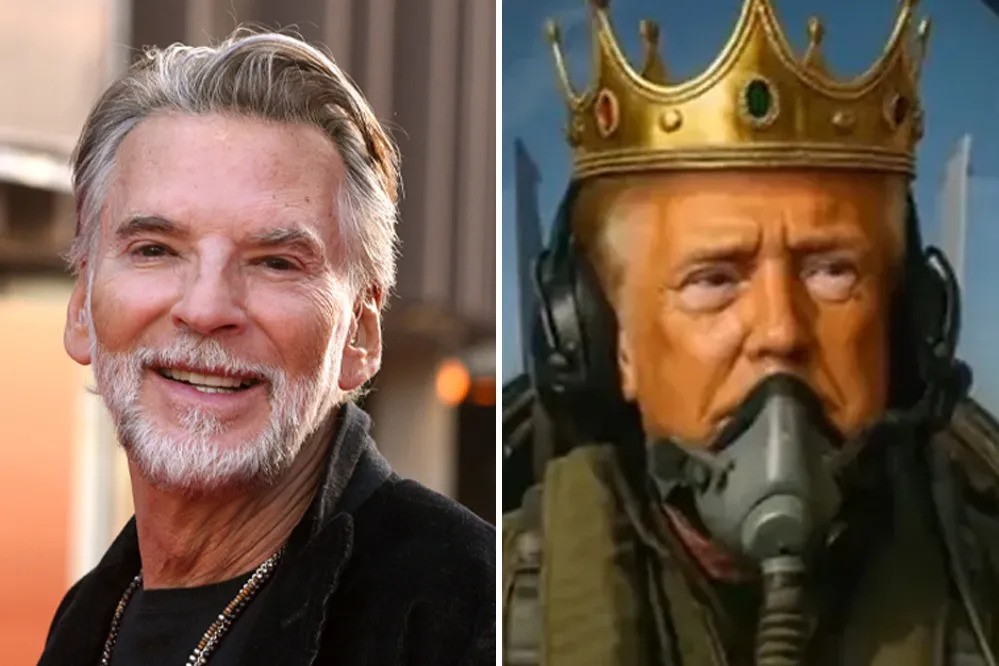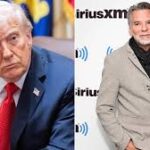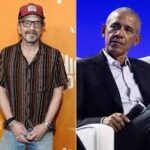In a moment that has reignited long-standing debates over the use of art in political messaging, singer-songwriter Kenny Loggins is speaking out against former President Donald Trump for using his iconic 1986 song “Danger Zone” in an unauthorized AI-generated video. The video, which Trump shared on his platform Truth Social on Saturday, October 18, features a digitally animated version of himself flying a fighter jet while dropping what appears to be fecal matter onto crowds of protesters.
The video, seemingly styled after the movie “Top Gun,” uses Loggins’ instantly recognizable track as its soundtrack—an energetic anthem that once symbolized high-octane patriotism and adventure but now finds itself at the center of a controversial political stunt. For Loggins, this was a step too far.
In a statement released just two days later on October 20, Loggins made his position crystal clear. “This is an unauthorized use of my performance of ‘Danger Zone.’ Nobody asked me for my permission, which I would have denied,” he said. “I request that my recording on this video is removed immediately.”
But Loggins’ objection wasn’t purely legal—it was deeply personal and principled. He went on to say, “I can’t imagine why anybody would want their music used or associated with something created with the sole purpose of dividing us. Too many people are trying to tear us apart, and we need to find new ways to come together.”
His words resonated with many Americans who have grown weary of the increasingly combative nature of political discourse in the country. In a time when music, media, and even truth itself are often co-opted to serve partisan aims, Loggins’ statement offered a plea for unity through art.
“We’re all Americans, and we’re all patriotic,” he said. “There is no ‘us and them’ – that’s not who we are, nor is it what we should be. It’s all of us. We’re in this together, and it is my hope that we can embrace music as a way of celebrating and uniting each and every one of us.”
The backdrop to this clash is a wave of massive nationwide demonstrations. On the very same day Trump shared the video—October 18—an estimated 2,700 rallies took place across the United States. These demonstrations, dubbed the “No Kings” protests, were organized in opposition to what many see as authoritarian tendencies from Trump and his political allies, as well as specific policies targeting immigrants, minority communities, and democratic institutions.
The protests drew millions of people, with turnout rivaling or even exceeding that of past historic events like the Women’s March in 2017 or anti-Vietnam protests in the 1960s. The crowds were notably diverse, including older Americans who had protested in their youth and were now returning to the streets, veterans who expressed disgust at what they described as “dictator-like leadership,” and young people frustrated by stagnant economic opportunities and political disenfranchisement.
In city after city, the message was consistent: Americans were taking to the streets to defend their constitutional rights and push back against a growing sense of alienation from the democratic process. For many, Trump’s video—which mocked these citizens as worthy of being bombed with excrement—was not just tasteless, but symbolic of the very contempt for public dissent they were protesting against.
As the video circulated, reactions poured in. Supporters of Trump celebrated it as a humorous jab at what they describe as leftist hysteria, an irreverent meme meant to “own the libs.” But for others, especially those who had spent the day peacefully demonstrating, the message felt deeply disrespectful and dangerous. Critics pointed out that by using a fighter jet to symbolically “attack” citizens exercising their First Amendment rights, the video blurred the line between satire and incitement.
Amid this swirl of controversy, the unauthorized use of “Danger Zone” raised serious legal and ethical questions. While the video may fall into a gray area under fair use or parody laws, the music itself remains protected by copyright—and the use of a specific recorded performance, especially for political messaging, typically requires permission from the artist or rights holders. Loggins is not the first artist to call out Trump or other politicians for using their music without consent, but his response adds to a growing list of high-profile objections.
What makes Loggins’ response particularly powerful is not just his legal objection, but his emotional appeal. He speaks not as a celebrity looking to score political points, but as an artist alarmed by how his work has been co-opted for purposes he finds antithetical to the values the song was meant to represent. “Danger Zone” may have been born in the age of Cold War bravado, but for Loggins, its meaning was never meant to be used as a soundtrack to shame fellow Americans.
This incident is also part of a broader conversation about the role of AI-generated content in shaping public discourse. The video Trump shared was digitally created, using advanced generative tools to simulate scenes that look cinematic and convincing—despite being entirely fictional. As the line between real and fake blurs, so too does the accountability behind the content.
In the past, political ads were carefully vetted, produced by professional teams, and subject to legal standards. Today, anyone with access to AI tools and a social media account can craft elaborate narratives, many of which are designed to provoke, mock, or mislead. And when a former president shares such content to millions of followers, the implications grow exponentially.
Some legal scholars and watchdog groups are already calling for tighter regulations around AI-generated media, particularly when it uses copyrighted material or targets vulnerable populations. The Federal Election Commission has been reviewing proposals for guidelines around AI in political campaigns, but enforcement remains patchy at best.
Meanwhile, platforms like Truth Social, where the video was shared, operate with fewer content restrictions than mainstream sites like Facebook or YouTube. That freedom allows for provocative content to spread unchecked—especially when it comes from influential figures like Trump, who maintains a loyal base despite numerous legal and political controversies.
The reaction from the Trump camp, true to form, was dismissive of the backlash. Rather than apologizing or removing the video, the team reportedly doubled down, framing the controversy as another example of cancel culture and political correctness run amok. A representative mocked Loggins’ request, suggesting he had “gone soft” and should “appreciate the honor” of being included.

But for many Americans, the issue isn’t about honor—it’s about respect, legality, and the integrity of artistic expression. Musicians, like all creators, have the right to control how their work is used, especially when it intersects with political speech. And when that speech involves targeting protestors with simulated violence, it raises ethical alarms that go far beyond copyright claims.
The protests that swept the nation on October 18 were about more than just Trump. They reflected deep-seated frustrations with political polarization, economic inequality, and systemic injustice. The “No Kings” slogan was not just a reference to Trump’s leadership style, but a broader rejection of concentrated power—whether it manifests in government, corporate media, or elite institutions.
Many of the demonstrators who showed up that day carried signs with messages like “Democracy, Not Dictatorship,” “We The People,” and “Liberty is Patriotic.” They chanted for immigrant rights, voting rights, climate justice, and protections for marginalized communities. They were not fringe radicals or violent agitators, but teachers, nurses, veterans, students, and everyday citizens who wanted to make their voices heard.
To see that collective action mocked in such a crude and dehumanizing way—by a video that uses both digital manipulation and iconic American music—felt like a slap in the face to many. The symbolism of a former president flying overhead and literally dumping on protestors was not lost on anyone. It was meant to provoke, and it succeeded.
But in provoking that response, the video also exposed a crucial truth: that the cultural battle over who gets to define patriotism, art, and dissent is far from over. As AI tools make it easier to remix reality, and as political figures use these tools to shape narratives, the stakes grow higher. If artists lose control over how their work is used, and if citizens lose trust in what they see and hear, then democracy itself is at risk.
Kenny Loggins may not have expected to be pulled into this political storm in 2025, nearly four decades after “Danger Zone” first hit the airwaves. But in standing up for the integrity of his music—and for the principle that art should unite, not divide—he joins a long tradition of artists who have refused to let their voices be used against their will.
In the coming weeks, we’ll likely see continued debate over the legality and ethics of the video. Whether Loggins or his representatives take further legal action remains to be seen. What’s already clear, however, is that the cultural impact of this moment goes far beyond one song or one video. It’s a snapshot of where America is right now—fractured, loud, creative, defiant, and still fighting over who gets to tell the story of who we are.

In the end, perhaps that’s the real danger zone—not the fighter jet fantasy, but the contested space where truth, art, and democracy intersect.










